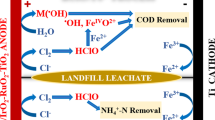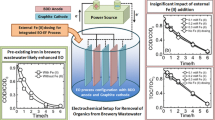Abstract
In this study, Fe-rich sludge was pretreated by dielectric barrier discharge (DBD) and used as a Fenton catalyst for the degradation of 2,4-dichlorophenoxyacetic acid (2,4-D) in aqueous solution, where hydrogen peroxide was in situ supplied from a glow discharge plasma (GDP) in contact with the solution. Synergistic mechanism of the two plasmas during 2,4-D degradation was explored. The Fe-rich sludge pretreated by H2-DBD could significantly accelerate the 2,4-D degradation as it converted Fe(III) in the sludge to the active Fe(II). 2,4-D can be completely removed in the presence of H2-DBD pretreated Fe-rich sludge with 25 min of GDP at pH0 3.0 and catalyst dosage of 1.0 g/L. Quenching experimental studies showed that both ·OH (oxidative degradation) and ·H (reductive dechlorination) were responsible for 2,4-D degradation. Reducing radicals (such as ·R and·H) formed during GDP can continuously reduce the Fe3+ back to Fe2+, which further promoted the degradation and dechlorination of 2,4-D. The results of three consecutive experiments indicated the stability and reusability of catalyst. This study provides a potential method for the recycle of Fe-rich sludge as a novel and cost-effective catalyst for 2,4-D removal from aqueous environments, which is significant for the terminal disposal of Fe-rich sludge.
Graphical Abstract







Similar content being viewed by others
References
Gan Q, Hou HJ, Liang S, Qiu JJ, Tao SY, Yang L, Yu WB, Xiao KK, Liu BC, Hu JP, Wang YF, Yang JK (2020) Sludge-derived biochar with multivalent iron as an efficient Fenton catalyst for degradation of 4-Chlorophenol. Sci Total Environ 725:138299
Huang YF, Huang YY, Chiueh PT, Lo SL (2020) Heterogeneous Fenton oxidation of trichloroethylene catalyzed by sewage sludge biochar: Experimental study and life cycle assessment. Chemosphere 249:126139
Walling C, Well T (1974) The ferric ion catalyzed decomposition of hydrogen peroxide in perchloric acid solution. Int J Chem Kinet 6:507–516
Li J, Pan L, Yu G, Xie S, Li C, Lai D, Li Z, You F, Wang Y (2019) The synthesis of heterogeneous Fenton-like catalyst using sewage sludge biochar and its application for ciprofloxacin degradation. Sci Total Environ 654:1284–1292
Zhang H, Xue G, Chen H, Li X (2018) Magnetic biochar catalyst derived from biological sludge and ferric sludge using hydrothermal carbonization: preparation, characterization and its circulation in Fenton process for dyeing wastewater treatment. Chemosphere 191:64–71
Sun H, Xie G, He D, Zhang L (2020) Ascorbic acid promoted magnetite Fenton degradation of alachlor: mechanistic insights and kinetic modeling. Appl Catal B 267:118383
Qu G, Li J, Liang D, Huang D, Qu D, Huang Y (2013) Surface modification of a granular activated carbon by dielectric barrier discharge plasma and its effects on pentachlorophenol adsorption. J Electrostat 71:689–694
Zhou J, Wang Z, Zuo R, Zhou Y, Cao X, Cheng K (2012) The surface structure and chemical characters of activated carbon fibers modified by plasma. Asia Pac J Chem Eng 7:245–252
Wu G, Zhang X, Hui H, Yan J, Zhang Q, Wan J, Dai Y (2012) Adsorptive removal of aniline from aqueous solution by oxygen plasma irradiated bamboo based activated carbon. Chem Eng J 185:201–210
Boudou JP, Martinez-Alonzo A, Tascon JMD (2000) Introduction of acidic groups at the surface of activated carbon by microwave-induced oxygen plasma at low pressure. Carbon 38:1021–1029
Slamani S, Abdelmalek F, Ghezzar MR, Addou A (2018) Initiation of Fenton process by plasma gliding arc discharge for the degradation of paracetamol in water. J Photochem Photobiol A 359:1–10
Dai F, Fan X, Stratton GR, Bellona CL, Holsen TM, Crimmins BS, Xia X, Thagard SM (2016) Experimental and density functional theoretical study of the effects of Fenton’s reaction on the degradation of Bisphenol A in a high voltage plasma reactor. J Hazard Mater 308:419–429
Marković M, Jović M, Daliborstanković KV, Roglić G, Gojgić-Cvijović G, Manojlović D (2015) Application of non-thermal plasma reactor and Fenton reaction for degradation of ibuprofen. Sci Total Environ 505:1148–1155
Hu P, Liu Y, Jiang B, Zheng X, Zheng J, Wu M (2015) High-efficiency simultaneous oxidation of organoarsenic and immobilization of arsenic in Fenton enhanced plasma system. Ind Eng Chem Res 54:8277–8286
Tao X, Yuan X, Huang L (2021) Effects of Fe(II)/Fe(III) of Fe-MOFs on catalytic performance in plasma/Fenton-like system. Colloids Surf, A 610:125745
Xu Y, Luo G, Pang Q, He S, Deng F, Xu Y, Yao H (2019) Adsorption and catalytic oxidation of elemental mercury over regenerable magnetic Fe-Ce mixed oxides modified by non-thermal plasma treatment. Chem Eng J 358:1454–1463
Fahmy A, El-Zomrawy A, Saeed AM, Sayed AZ, El-Arab MAE, Shehata HA (2018) Modeling and optimizing acid orange 142 degradation in aqueous solution by non-thermal plasma. Chemosphere 210:102–109
Li YW, Liu LW, Zhang QZ, Su Y, Zhou MH (2021) Hybrid electro-Fenton and peroxi-coagulation process for high removal of 2,4-dichlorophenoxiacetic acid with low iron sludge generation. Electrochim Acta 382:138304
Serra-Clusellas A, Angelis LD, Lin C, Vo P, Bayati M, Sumner L, Lei Z, Braga N, Bertini LM, Mazza J, Pizzio LR, Stripeikis JD, Rengifo-Herrera JA, Cortalezzi MMFd (2018) Abatement of 2,4-D by H2O2 solar photolysis and solar photo-Fenton-like process with minute Fe(III) concentrations. Water Res 144:572–580
Kusmierek K, Swiatkowski A (2016) Adsorption of 2,4-dichlorophenoxyacetic acid from an aqueous solution on fly ash. Water Environ Res 88:231–238
Singh RK, Philip L, Ramanujam S (2017) Removal of 2, 4-dichlorophenoxyacetic acid in aqueous solution by pulsed corona discharge treatment: effect of different water constituents, degradation pathway and toxicity assay. Chemosphere 184:207–214
Zhang H, Zhang Q, Miao C, Huang Q (2018) Degradation of 2, 4-dichlorophenol in aqueous solution by dielectric barrier discharge: effects of plasma-working gases, degradation pathways and toxicity assessment. Chemosphere 204:351–358
Hickling A, Ingram MD (1964) Glow-discharge electrolysis. J Electroanal Chem 8:65–81
Wang L, Liu P, Chen T (2016) Glow discharge plasma induced dechlorination and decomposition of dichloromethane in an aqueous solution. Plasma Chem Plasma Process 36:615–626
Yang Y, Wan K, Yang ZP, Li DL, Li GX, Zhang SL, Wang L, Yu X (2020) Inactivation of antibiotic resistant Escherichia coli and degradation of its resistance genes by glow discharge plasma in an aqueous solution. Chemosphere 252:126476
Xu ZM, Xue XJ, Hu SH, Li YX, Shen J, Lan Y (2020) Degradation effect and mechanism of gas-liquid phase dielectric barrier discharge on norfloxacin combined with H2O2 or Fe2+. Sep Purif Technol 230:115862
Wang L, Jiang XZ (2009) Unusual catalytic effects of iron salts on phenol degradation by glow discharge plasma in aqueous solution. J Hazard Mater 161:926–932
Lin SH, Lo CC (1997) Fenton process for treatment of desizing wastewater. Water Res 31:2050–2056
Lipczynska-Kochany E, Sprah G, Harms S (1995) Influence of some groundwater and surface waters constituents on the degradation of 4-chlorophenol by the Fenton reaction. Chemosphere 30:9–20
Fukuchi S, Nishimoto R, Fukushima M, Zhu Q (2014) Effects of reducing agents on the degradation of 2, 4, 6-tribromophenol in a heterogeneous Fenton-like system with an iron-loaded natural zeolite. Appl Catal B 147:411–419
Buxton GV, Greenstock CL, Helmane WP, Ross AB (1988) Critical view of rate constants for reactions of hydrated electrons, hydrogen atoms and hydroxyl radicals (·OH/·O-) in aqueous solution. J Phys Chem Ref Data 17:513–886
Bullock A, Gavin D, Ingram M (1980) Electron spin resonance detection of spin-trapped radicals formed during the glow-discharge electrolysis of aqueous solutions. J Chem Soc Faraday Trans 76:648–653
Brillas E, Calpe JC, Casado J (2000) Mineralization of 2,4-D by advanced electrochemical oxidation processes. Water Res 34:2253–2262
Liu F, Liu Y, Lu YJ, Wang ZZ, Cheng J (2018) Electrical analysis of triboelectric nanogenerator for high voltage applications exampled by DBD microplasma. Nano Energy 56:482–493
Chen H, Zhang Z, Yang Z, Yang Q, Li B, Bai Z (2015) Heterogeneous Fenton-like catalytic degradation of 2,4-dichlorophenoxyacetic acid in water with FeS. Chem Eng J 273:481–489
Buxton GV, Greenstock CL, Helman WP, Ross AB (1988) Critical review of rate constants for reactions of hydrated electrons, hydrogen atoms and hydroxyl radicals (⋅OH/⋅O-) in aqueous solution. J Phys Chem Ref Data 17:513–886
Moussavi G, Rezaei M (2017) Exploring the advanced oxidation/reduction processes in the VUV photoreactor for dechlorination and mineralization of trichloroacetic acid: parametric experiments, degradation pathway and bioassessment. Chem Eng J 328:331–342
Homlok R, Mile V, Takács E, Járvás G, Góger S, Wojnárovits L (2020) Comparison of hydrogen atom and hydroxyl radical reactions with simple aromatic molecules in aqueous solution. Chem Phys 534:110754
Gao YQ, Zhang J, Li C, Tian FX, Gao NY (2020) Comparative evaluation of metoprolol degradation by UV/chlorine and UV/H2O2 processes. Chemosphere 243:125325
Zhou C, Gao NY, Deng Y, Chu WH, Rong WL, Zhou SD (2012) Factors affecting ultraviolet irradiation/hydrogen peroxide (UV/H2O2) degradation of mixed N-nitrosamines in water. J Hazard Mater 231–232:43–48
Chen H, Zhang Z, Feng M, Liu W, Wang W, Yang Q, Hu Y (2017) Degradation of 2, 4-dichlorophenoxyacetic acid in water by persulfate activated with FeS (mackinawite). Chem Eng J 313:498–507
Xu L, Wang J (2012) Fenton-like degradation of 2,4-dichlorophenol using Fe3O4 magnetic nanoparticles. Appl Catal B 123–124:117–126
Liu Y, Yan Z, Chen R, Yu Y, Chen X, Zheng X, Huang X (2019) 2,4-Dichlorophenol removal from water using an electrochemical method improved by a composite molecularly imprinted membrane/bipolar membrane. J Hazard Mater 377:259–266
Acknowledgements
This work was supported by the National Natural Science Foundation of China (51008262), the Natural and Science Guiding Project of Fujian Province (2019H0036), the Climbing Program for Research of Xiamen University of Technology (No. XPDKT18011).
Author information
Authors and Affiliations
Corresponding author
Ethics declarations
Conflict of interest
The authors declare that they have no known competing financial interests or personal relationships that could have appeared to influence the work reported in this paper.
Additional information
Publisher's Note
Springer Nature remains neutral with regard to jurisdictional claims in published maps and institutional affiliations.
Appendix
Appendix
See Tables 3, 4, 5, 6 and Figs. 7, 8, 9, 10, 11, 12, 13, 14.
Rights and permissions
Springer Nature or its licensor (e.g. a society or other partner) holds exclusive rights to this article under a publishing agreement with the author(s) or other rightsholder(s); author self-archiving of the accepted manuscript version of this article is solely governed by the terms of such publishing agreement and applicable law.
About this article
Cite this article
Huang, S., Huang, Q., Gan, J. et al. Synergistic 2,4-D Degradation by Fenton Reagent Obtained from Glow Discharge Plasma Formed H2O2 and DBD Pretreated Fe-Rich Sludge Catalyst. Plasma Chem Plasma Process 43, 491–511 (2023). https://doi.org/10.1007/s11090-022-10306-7
Received:
Accepted:
Published:
Issue Date:
DOI: https://doi.org/10.1007/s11090-022-10306-7












